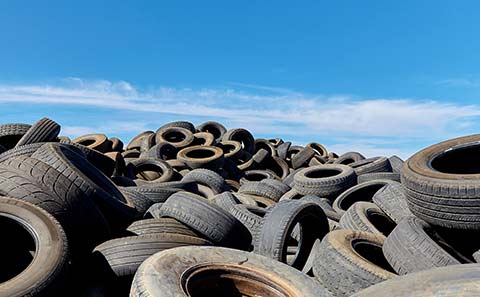Tire balancing is important. Correctly balanced tires ensure your vehicle performs without issues, eliminating vibrations and irregular wear, and optimizing the vehicle’s fuel economy.
Since tire balance affects so many aspects, it is highly likely that when you notice something wrong with the tires, tire imbalance will be the culprit. But, what is exactly tire balancing and what does it offer?
Let’s take a look…

What Does Tire Balancing Do?
Tire balancing ensures that driving pressure affects the entire tire-wheel combination evenly. This makes sure to optimize the tire’s overall performance. Yes, an imbalanced tire can cause lots of problems for both the vehicle and its driver.
But, how can they fix out-of-balance tires?
During the balancing process, the tire and wheel are placed on a machine that can show their lighter and heavier areas. When they are pinpointed, weights are added to specific areas on the tire to balance it.
Tire shops employ different types of tire balancing methods to achieve the best results.
Static Balancing
Static balancing was the go-to method for vintage cars and motorcycle rims – both vehicle types used narrower tires than modern cars do.
This type of balancing means the balance point of a tire around its axis of rotation. In other words, the tire is mounted on a free rotating axle to see if it is balanced or not. If the tire is balanced, it will remain stationary, no matter what position you leave it in. However, if the tire has an imbalance, its heavy part will drop to the bottom.
This method will have you place matching weights opposite the heavy spots to correct the tire’s balance.
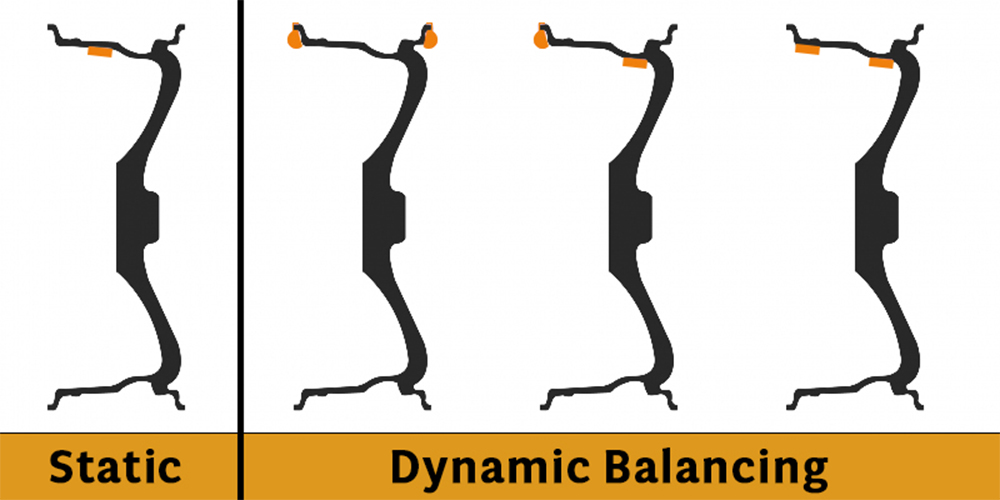
Dynamic Balancing
Most modern vehicles will need dynamic tire balancing to properly balance their tires. These vehicles have wider footprints, which are at least 4 inches wide. The wider the tire and wheel combination is, the more crucial it becomes to use this tire balance method.
When this method is used, it means that the imbalance pulls the tire’s axis point towards its rotation. In more simple terms, the unbalanced tires wobble. While a static imbalance appears in one direction, a dynamic imbalance can appear all over the tire.
Therefore, dynamic balancing places the required weight on the opposite (diagonally) of the off-centered imbalance.
Road Force Balancing
If you wish to use the newest balance technique, road force balancing is for you. This method used road condition simulation by using a larger roller to place pressure onto the tire. It uses a computer program to see tire imbalance even in complicated cases.
Furthermore, this method provides the best results. While you will need a well-trained technician to operate the tire balancing machine, it gives an insight into what’s to blame – wheel or tire imbalance.

Signs that Your Tires are Imbalanced
Luckily, when to balance your tires is not guesswork. There are specific signs you will certainly notice when an imbalanced tire starts acting up.
You should get your tires balanced when you notice any of the following issues.
Driving Vibrations
An incorrectly balanced tire will shake, shimmy, wobble – you name it. However, what these adjectives have in common is when applied to tires they will mean increased road vibrations.
There is little difference between a front and rear tire imbalance when it comes to this. The only significant variation is the place you will feel the vibrations. If your steering wheel is jumpy, a front tire has the issue. However, if the vibrations are felt through the car seats and floor, a rear axle tire is causing problems.

Uneven Tire Wear
Tire wear is a serious issue, especially as unbalanced tires result in uneven wear. The wobbling motion of the imbalanced tire will result in irregular and accelerated tread wear. This is even more true if the tire is mounted on the rear axle (as that axle is stable).
This type of tread wear will significantly shorten the tire’s overall service life.
Car Suspension Problems
The vehicle’s suspension parts can get damaged from an imbalance in the tires. This is due to the wobbling performance of said tires, which causes vibrations. The suspension system will need to keep up with the vibrating tires throughout the drive.
This means a strenuous performance for both the vehicle and tires. However, when it comes to the suspension system, changing its parts will cost you more than tire balancing.
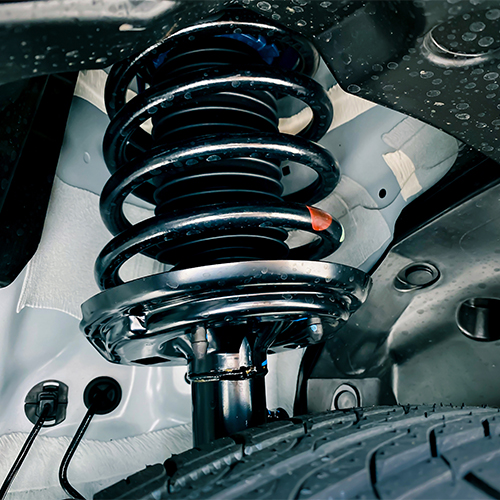
Increased Fuel Consumption
Improper balance results in a drop in the tires’ performance, as they endure more pressure during the drive. Higher pressure levels increase their rolling resistance, which leads to the vehicle needing more fuel to run.
In other words, when you notice having to reach deeper in your wallet to pay for gas, have the tires checked and balanced.
Out of Round Tires
Another big issue vehicle owners face is out-of-round tires. While this usually happens after the tires have been in use for a while, it can also be a manufacturing fault of new tires. If the latter is the case, the manufacturing warranty should cover it.
But, what are out-of-round tires?
These are tires that have deformations. Either their tread wear is so irregular professionals cannot balance them, or their internal structure suffered damage and is not even. Whatever the case might be, no one can balance these tires. Car owners will need to replace them.
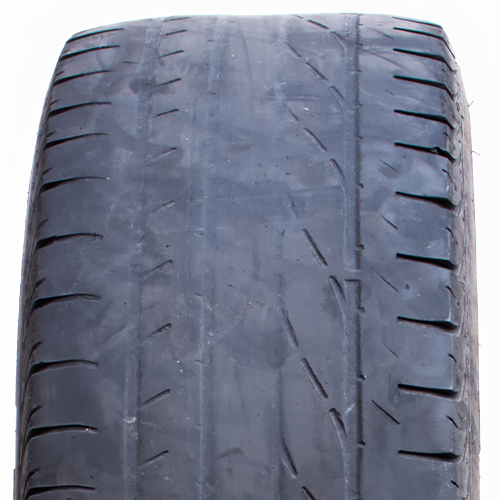
How Often to Balance Tires?
The general rule of thumb is to balance your tires after every 3,000 to 6,000 miles, which is about once a year (depending on how often you use your vehicle). However, there are other instances when it is a good idea to visit the tire shop.
Have your tires balanced in these cases:
- Buying new tires or wheels
- During tire rotations
- Excessive vibrations at higher speeds
- Uneven tire wear starts to develop
- After hitting potholes
Tire Balancing vs Alignment
What’s the difference between tire balancing and the vehicle’s alignment? Aren’t they the same?
No, they are not the same.
Tire balancing refers to imbalanced tires. Alignment is the incorrect angle of the suspension system (the complex system holding the tire on the axle).
Now, problems and confusion may arise as they literally have the same symptoms. Tire wobbling, uneven wear, increased fuel consumption, etc. are problems that can be the result of an unbalanced tire or incorrect alignment. Visiting a tire balancing machine or fixing the alignment will often improve performance.
Therefore, it is important to check both issues when you notice problems. Often one of them will be the culprit.
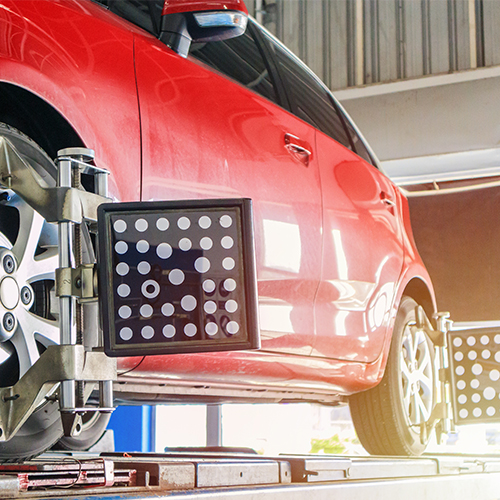
How to Balance Tires at Home?
If you know enough about your vehicle and its various parts, you can balance your tire set on your own at home. Sort of DIY it. But, how to go about it?
There are two ways you can do this: with or without a tire balancer.
With a Tire Balancer
If you own a tire balancer, you will just need the remaining tools to remove the wheel and various weights. With a static or spin balancer, these are the steps:
- Remove the wheel from the car and take off all weights
- Thoroughly clean the tires of debris, the rims, and the rest of the wheel. If you wash them, make sure they are dry before you continue.
- Place the rim/tire combo on the tire balancer. For modern cars, we recommend a dynamic balancer – you will need to spin the wheels. However, if you use a static one, let them settle into a stational position.
- Mark the place where you need to add the new weights, opposite of where the imbalance is.
- Put on the weights, recheck the balance of the tire, and if necessary adjust the weights until you get a smooth roll with a dynamic balancer or a perfect line with a static one.
- Lastly, mount the tires back onto the vehicle.
Without a Tire Balancer
Balancing tires without a balancer is still possible, but it will require a bit more work. The process of trial and error is the way to go here. The first few steps are somewhat similar to our previous list, as they are:
- Find the tire that you may think has an imbalance and remove the weights from it (do not remove the wheel from the vehicle).
- Clean the tire as best as you can, just be sure to remove debris from between the tread elements.
- Add a weight to the 12 o’clock position and check whether the tire starts vibrating at higher speeds. You can do this by revving the car.
- If it still vibrates, move the weight 45 degrees away from the first position. Rev the car again and check for vibrations. You will need to keep an eye on the speed as well. If vibrations start at a higher speed than before, add weight to this spot.
- Vibrations are still present; add more weight. Move 45 degrees away and do the process once more.
- With this process, it will take a while, but once you find the sport causing the issue, add more weight there.
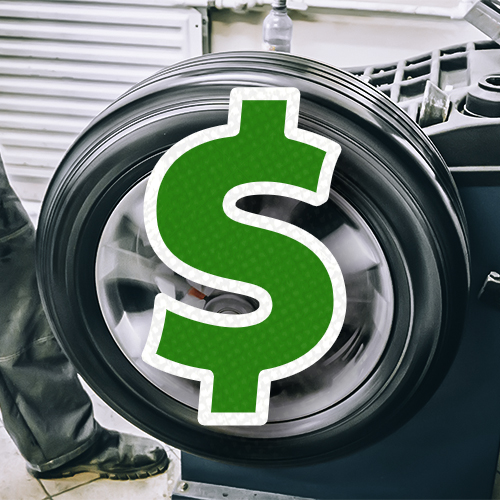
Frequently Asked Questions
Are Blemished Tires Safe?
It is easy to tell which is an out-of-balance tire. Imbalanced tires wobble and hop during their performance. This causes excessive vibrations in the steering wheel (when the front tire is imbalanced) or the car seat and floor (when the rear tire causes problems).
How Long Does It Take to Balance Tires?
If you only require tire balancing, the service can take between 45 minutes and 2 hours for a set of four tires. Keep in mind that older, imbalanced tires usually take longer to balance than new tires, as they tend to be more out-of-shape.
How Much Does Tire Balancing Cost on Average?
Usually, the cost to balance tires is between $30 to $100 for four tires. However, it will depend on a few factors like the vehicle’s make and model, as well as the condition of the tires. You can expect a $10 to $15 service cost per tire.
